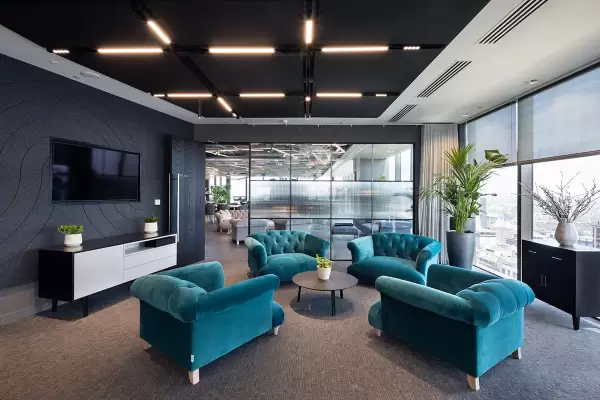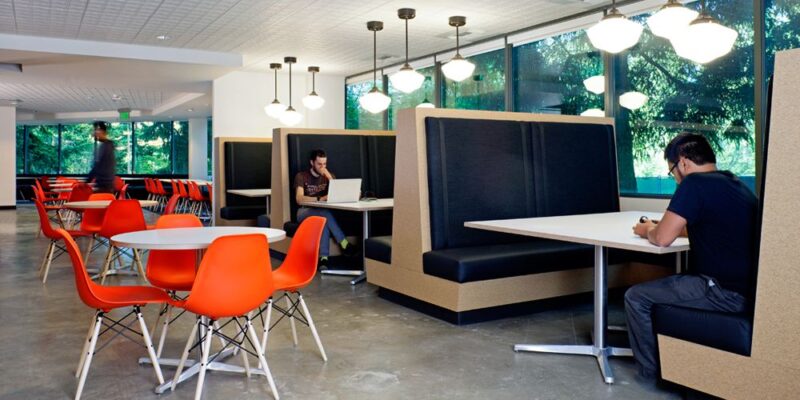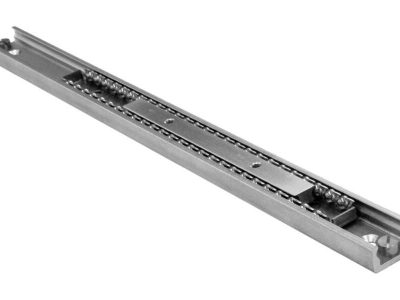When designing an office, the importance of colour is often overlooked. Yet, the hues used throughout a workspace can have a profound effect on mood, energy levels, and overall productivity. Whether you’re planning a full-scale office renovation or simply looking to make a few impactful updates, understanding how different colours influence behaviour can help you create a more harmonious and efficient work environment.
The Psychology of Colour in the Workplace
Colour psychology is a field that studies how different shades can affect emotions and behaviours. In the context of office fitouts, it’s essential to choose colours that not only reflect the brand’s identity but also foster a positive work atmosphere. The right combination of hues can promote creativity, reduce stress, and enhance focus, ultimately leading to a more productive workforce.
Blue: Calm and Focused
Often referred to as the colour of productivity, blue has been shown to enhance focus and mental clarity. Its calming effect helps reduce stress and anxiety, making it ideal for high-pressure environments such as offices where attention to detail is critical. Blue can be particularly effective in spaces where analytical thinking is required, such as finance or tech companies.
For offices with open-plan layouts, varying shades of blue can be used to create a sense of flow without overwhelming the senses. Pairing blue accents with ergonomic furniture and functional pieces, such as office tables for sale, can enhance the overall workspace and create a more structured feel.

Green: Balanced and Rejuvenating
Green symbolises nature and balance, making it an excellent choice for offices that prioritise employee wellbeing. Studies have shown that green can reduce eye strain and create a feeling of calm, which is especially beneficial in environments where employees spend long hours staring at screens.
Adding plants or green wall features can enhance this effect, bringing a touch of nature indoors. For meeting rooms or areas designed for brainstorming, green can also stimulate creativity without being too overpowering. Whether through wall paint or strategically placed furniture, green can infuse a space with tranquillity and balance.
Yellow: Energetic and Optimistic
Yellow is the colour of optimism and energy, making it a great choice for collaborative spaces or break areas where you want to inspire creativity and positivity. However, it’s important to use yellow sparingly, as too much can lead to overstimulation and distraction.
Incorporating yellow in small doses – perhaps through accent chairs, artwork, or even table accessories – can add a vibrant, uplifting energy to the office without overwhelming the senses. For offices looking to create a dynamic and positive atmosphere, touches of yellow can serve as an excellent mood booster.
Red: Stimulating and Powerful
Red is a bold and stimulating colour, often associated with energy and action. While it may not be ideal for quiet work areas where concentration is key, red can be used effectively in spaces where physical activity or collaboration takes place. For example, red accents in a conference room can spark lively discussions and energise participants during meetings.
When used in moderation, red can evoke feelings of passion and power, making it suitable for industries that thrive on high energy and innovation. Pairing red with neutral tones can balance its intensity and prevent it from becoming overwhelming.
Neutral Colours: Sophisticated and Versatile
Neutral tones like white, grey, and beige remain staples in office design for good reason. These shades provide a blank canvas that can be easily customised with pops of colour or artwork, allowing for a sleek and modern look. Neutrals create a sense of spaciousness and cleanliness, which can help reduce distractions and promote mental clarity.
Incorporating high-quality furnishings in neutral shades can enhance the minimalist aesthetic, allowing the focus to remain on work rather than overwhelming design elements. Neutral tones also pair well with bolder accent colours, giving offices the flexibility to refresh their look over time without needing a complete redesign.
Creating the Right Balance
While individual colours can influence mood and productivity, the overall success of an office fitout depends on how these colours are balanced; too much of any single hue can lead to overstimulation or boredom. By carefully blending different shades and incorporating a variety of textures and materials, you can create an office environment that meets the needs of your team and reflects your company’s identity.
Whether you’re designing a new office from scratch or updating an existing space, choosing the right colours – and furniture – will ensure your office is as productive as it is visually appealing.









Comments